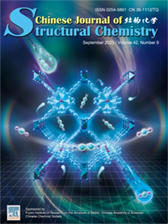
Cover Picture
Metal-ion-tuned metal-organic frameworks for C2H2/CO2 separation
Meng Sun, Hongyan Liu, Xiaokang Wang, Xinlei Yang, Fei Gao, Deyu Xie, Weidong Fan*, Yinfeng Han*, Ben Xu, Daofeng Sun Submit a Manuscript
Metal-ion-tuned metal-organic frameworks for C2H2/CO2 separation
Meng Sun, Hongyan Liu, Xiaokang Wang, Xinlei Yang, Fei Gao, Deyu Xie, Weidong Fan*, Yinfeng Han*, Ben Xu, Daofeng Sun Submit a Manuscript
An enzyme-free glucose sensing device based on TiO2 nanorod array photoelectric catalysis
Anna Su, Qiumei Lei, Gaoqi Tian, Yaolan Yang, Shuqing He, Li Yan, Xin Hu, Tao Ji*, Shijie Li*, Junqing Hu
Chin. J. Struct. Chem., 2023, 42: 100133. DOI: 10.1016/j.cjsc.2023.100133
September 15, 2023
Glucose; TiO2; Enzyme-free; Photocatalysis; Electrochemical biosensor
ABSTRACT
A simple one-step hydrothermal method is used to prepare an enzyme-free photoelectric combined glucose sensor based on TiO2NRs/FTO with low cost, sample two-electrode, and excellent detection. Under 380 nm light (0.5 mW cm−2) irradiation and a positive voltage, holes are accumulated on TiO2NRs surface, catalyzing glucose and forming a photocurrent without the need for an enzyme, such as Glucose oxidase (GOx). The designed sensor exhibits high sensitivity (about 0.96 μA mM−1 cm−2, without GOx) and excellent linear relationship in the glucose concentration range of 5–15 mML−1. The prepared glucose sensor performs better with a sensitivity of 1.48 μA mM−1 cm−2 when a certain amount of GOx is mixed in the detected solution. In addition, the sensor has excellent anti-interference resistance to non-reducing chitosan and reducing ascorbic acid with short response time (less than 5 s); thus, it can be used in quick detection with a double electrode system. This sensing device has the advantages of simple fabrication, easy storage, and reusability; therefore, it can be very promising in the portable and rapid monitoring of human blood glucose levels.







